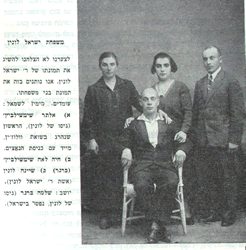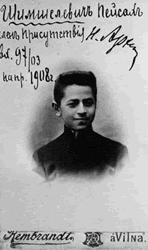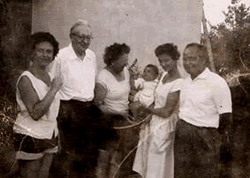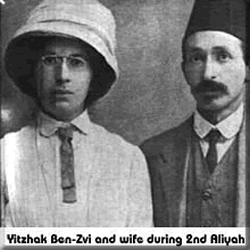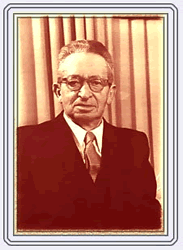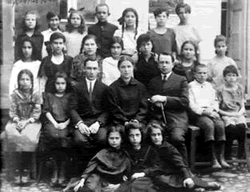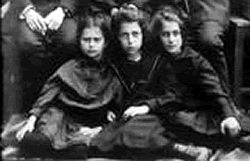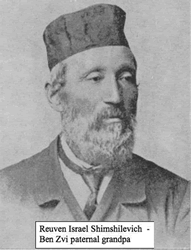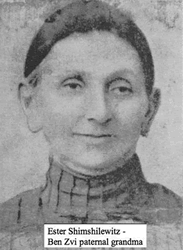President Ytzhak and Rachel (Yanait) Ben Zvi with friends in Ashkelon - July 25, 1959
#shshz-5:
YITZHAK BEN-ZVI
1884-1963
Second President of the State of Israel
 Yitzhak Ben-Zvi - Zionist labor movement leader and historian - was elected the second President of the State of Israel on December 8, 1952. Ben-Zvi was born in the town of Poltava in the Ukraine in 1884 as Yitzhak Shimshelevitz, the son of a Jewish scholar and writer who Hebraicized his name to Zvi Shimshi (thus, the name Ben-Zvi - "son of Zvi.") Born into a family from Smorgon, steeped in Jewish tradition and Zionist fervor, Ben-Zvi's name is closely associated with Jewish self-defense: at the age of twenty, in the wake of the 1903 Kishinev Pogrom, he was one of the founders of a Jewish defense organization in the Ukraine. After immigrating to Palestine in 1907, Ben-Zvi was a central figure in Hashomer - the defense organization that guarded Jewish agricultural settlements in the early days of the Zionist enterprise.Expelled from Palestine by the Ottoman authorities (together with David Ben-Gurion, later the first Prime Minister of Israel) during the First World War because of Zionist activities, the pair organized a base for labor Zionism in the United States. In 1917, they joined the 39th Kings' Fusiliers, returning to Palestine with the British army. Later, in the wake of Arab attacks on Jewish communities in the early 1920s, Ben-Zvi became a founding member of the Haganah, the underground Jewish defense organization.
An avid socialist, Ben-Zvi was a leader of socialist Zionist parties from an early age, and was among the founders of the Histadrut - General Federation of Labor in 1920. A key political figure, he served in many senior posts. Between 1931 and 1948 he was first chairman and then President of the Va'ad Haleumi (the national council) - a "diplomatic post" in which he served as the chief representative of the Jewish community vis-a-vis the mandatory authorities. Elected to the First Knesset in January 1949, Itzhak Ben-Zvi was chosen as President of the State of Israel in 1952.
Yitzhak Ben-Zvi resigned his Knesset post and moved the President's residence from Rehovot to Jerusalem. However, he was adamant that the President should serve as an example for the citizenry and that his home should reflect the austerity and simplicity of the times. Thus, President Ben-Zvi insisted on living in a wooden prefabricated dwelling - accommodations that were augmented by two larger similar buildings in the yard, used for official receptions.
It was Ben-Zvi, renowned for his warmth, openness and simple manner, who first held some of the annual events which have since become traditions - including "open house" at the President's residence during the festival of Sukkot and the annual Independence Day reception, an event in which ordinary citizens participate, in addition to the reception held for local dignitaries and the diplomatic corps.
Ben-Zvi took great interest in the various Jewish communities who came to Israel, and in the history of Jewish settlement in the Land of Israel. He focused on the traditions, rituals and religious art of Oriental Jewish communities - Yemenite, Persian, Kurdish, Bucharan and others. He himself wrote some twenty volumes on the history of Jewish communities as well as on the unbroken chain of Jewish settlement in the Land of Israel since the days of the Second Temple. His work laid the foundations for Yad Yitzhak Ben-Zvi, which is devoted to the study of Jewish communities as well as of the Land of Israel and Jerusalem. However, Ben-Zvi's devotion to the "Tribes of Israel," as they were called at the time, was more than academic. A proponent of "diversity" decades before the word became popular, Ben-Zvi invited representatives of different Jewish ethnic communities and of minority communities to the President's residence - a monthly event attended by 100-200 guests from all over the country. Each group related the history of its community, its customs, rituals and traditions, and displayed the items which evolved around these traditions.
In keeping with this interest, Ben-Zvi enhanced the decor of the President's residence with ceremonial objects and handicrafts of different ethnic communities. A rug woven by Yemenite women sparked the establishment of Maskit - a prestigious non-profit chain which for decades encouraged such crafts and marketed them.
Ben-Zvi served two full five-year terms as President, and was reelected for a third term in December 1962 (when the Presidency was not yet limited by law to two terms). He died six months later on April 23, 1963.
After his death, the Yad Yitzhak Ben-Zvi research institute was established on the site of the wooden buildings which had served for over a decade as the official residence of the second President of the State of Israel.
In the Yizkor books for the shtetls Vishnevo and Dolhinov they write about the members of the Shimshelevitz family who lived in the shtetls and were uncles or cousins of YiItzhak Ben-Zvi (Shimshelevitz)
The Columbia Encyclopedia, Sixth Edition.  2001.
Ben-Zvi, Yizhak
(ytsh´hÃ?k bn-tsv) (KEY) , 1884â€"1963, president of Israel (1952â€"63), b. Russia, originally named Issac Shimshelevitz. A Zionist, he fled Russia in 1905 because of his activities in the Jewish self-defense movement and settled (1907) in Palestine. With David Ben-Gurion and other Zionist leaders he helped create the Jewish state. In 1952 he succeeded Chaim Weizmann as president of Israel; he was reelected in 1958 and again in 1962. He died in office in 1963. He was a historian and a scholar of note in the field of Jewish ethnology. His writings include The Moslem World and the Arab World (1937), The Exiled and the Redeemed (new ed. 1961), and The Hebrew Battalions: Letters (1969).
Szymszelewicz ( Shimshelevitz)Aron; Dentist (relative of Yitzhak
Ben Zvi; Dolhinov 1929 Business Directory
Among those who used to frequent the Beis Hamussar were such luminaries as HaRav Yosef Shimshelevitz zt'l
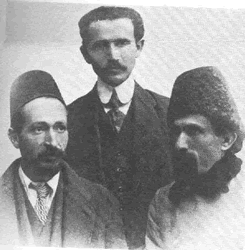
#shshz-7:
pictured:Yitzhak ben Zvi, David ben Gurion, and Yitzhak Shochet in Turkey
Rahel Yanait Ben-Zvi
(1886-1979)
Rahel Yanait Ben-Zvi was born in 1886 in Malin, Ukraine. As a child she
studied Hebrew in “heder� (Hebrew classes)
and later at a Russian gymnasium. In 1905 she was a delegate to
the 7th Zionist Congress and a year later she participated in the founding
committee of the Po’alei Zion Labour Party.She immigrated
to Eretz Israel in 1908 and dedicated her life to building the country.Â
She was one of the founders of the Hashomer Movement, edited the “Ahdut�
publication of the Po’alei Zion Party and helped to
establish the Hebrew Gymnasium High School in Jerusalem, where she then
taught.
Even before moving to Eretz Yisrael, she aligned herself with the labor
movement and worked to establish chapters of Poalei Zion in Russia. She
was educated in Russia and later in France, studying agronomy. Ben-Zvi
arrived in Eretz Yisrael in 1908, and became a leader of HaShomer, whose
members were largely affiliated with the Poalei Zion, and later, T'nuot
HaPo'alot, a women's labor movement. She served on the editorial board
of “Ha-Ahdut,� the Hebrew newspaper of
Poalei Zion, and following World War I, she became a founder of Ahdut
Ha-Avodah Labor Party. Ben-Zvi's activism also emerged during the wars.
In World War I she volunteered for the British, and kept contacts between
HaShomer and the Nili group. Before the establishment of the State, she
was a leader of the Haganah in Jerusalem. Ben-Zvi contributed notably
to the field of education, helping to found and teaching at the Hebrew
Gymnasium in Jerusalem, the second modern high school in the country,
and later establishing an agricultural high school for girls near Talpiot,
Jerusalem. Shortly after the establishment of the State, the agricultural
youth village at Ein Kerem was launched, largely through her efforts.
In 1918, she married Yitzhak Ben-Zvi, whom she had known through her activities
with Poalei Zion, HaShomer, and “Ha-Ahdut.�
When, in 1952, her husband became the second president of Israel, she
assisted him in his official duties and worked with him to make the president's
house a landmark central to all Israelis. Following her husband's death
in 1963, Ben-Zvi became an active member of Yad Ben-Zvi, the historical
and research institute named for her husband. With her husband, Ben-Zvi
wrote Eli, (Eli was a Kibbutz Beit Keshet member) a book about the son
they lost in the War of Independence. She later published her own memoirs,
and following her husband's death, helped to edit his scholarly writings.
For her special contribution to the State and to Israeli society, Ben-Zvi
was awarded the Israel Prize in 1978.
http://www.us-israel.org/jsource/biography/rbenzvi.html
http://www.eilatgordinlevitan.com/dolhinov/d_images/
list of donors who helped Jews suffering from hunger in 1871, mentions
a Kopcheve Jew, as published in the Hebrew periodical "HaMagid".
A list of donors for "The Settlement of Eretz Israel", published
in"HaMeilitz" in 1899 and 1903, mentions many Kopcheve Jews.
Their representative was Ben-Zion Shimshelevitz. More Kopcheve Jews appear
in a list in 1909: B.Shimshelevitz
cem20_b.gif
Locally born personalities
included the historian Elkhanan (Eduard) Kalman (1891-1939); B"Z.
Shimshelevitz, scholar and ardent Zionist, who published articles in "HaOlam",
an uncle of the second president of Israel - Yitskhak ben TsviKopcheve
is located in the south-western corner of Lithuania, about 8 km (5 miles)
from Poland and the same distance from Belarus, in an area full of rivers,
lakes and woods. The river Baltoji Ancia and the nearby rivers Juodoji
Ancia and Nieda flow through Kopcheve
Korelicze, Belarus ;
The names of the holy ones
Shimshelevitz Baruch Shimshelevitz Chana Shimshelevitz Leah Shimshelevitz
Mordechai Shimshelevitz Nissan Shimshelevitz Gershon
opened the first Beis Hamussar in Yerushalayim which had been a training
ground for the great personalities of Yerushalayim who developed within
it.
Among those who used to frequent the Beis Hamussar were such luminaries
as HaRav Yosef Shimshelevitz zt'l,
Brothers/Sisters-in-Law;
Yitzhak Ben-Zvi Tamar Eshel
Yitzchak Shimshelevitz (Ben-Zvi) was born on November 24, 1884. He was
the eldest son of Zvi Shimshelevitz (Shimshi), a writer, scholar, and
descendent of a distinguished and highly respected rabbinical family
Yitzhak Ben Zvi had lived in
a simple wooden hut in Rechavia for more than a quarter century. Since
Ben Zvi had no interest in luxuries, the State had to convince him to
move into a formal residence. The State bought the house next to Ben Zvi's
hut, which served as the official residence of the president until Beit
HaNassi was built in 1971.
In 1918, a Yiddish book by David BenGurion and Yitzhak Ben-Zvi, Eretz
Yisrael in the Past and Present, was published in New York by the Poale
Zion Palestine Committee. The authors note that long after the destruction
of the Second Temple — and even after the defeat of
Shimon Bar Kokhba, leader of the Jewish revolt against the Romans in the
second century C.E. — large masses of Jews still tilled
the soil of Eretz Yisrael.
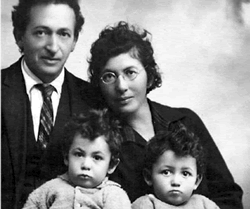
Date 1923/24
City Panevezys
Portrait of graduating students of the `folkshul' (Jewish elementary school) with teachers (left to right) Motl Mahler (holding a cigarette), Rivke Mahler and P. Shimshelevitsh in front of the Jewish People's Bank (Yiddish and Lithuanian signs).
SHIMSHELOWITZ Dov Ber husband of Bluma Sarah Tzizling wed Liepaja, Lat. Hamelitz #145 1897
SHIMSHELEWITZ Bluma Sarah on occasion of Hershoter-Izwolk wedding Vilnius, Lith. Hamelitz #77 1901
SHIMSHELEWITZ Bluma Sarah on occasion of Zalkind-Einhorn wedding Vilnius, Lith. Hamelitz #77 1901 Name Nationality Visa Date Number
SZYMSZELEWICZ, Icko Polnisch 6 August 1940
Sugihara Database
SHIMSHELEVICH, Mortkhel      Thirteenth lane (off of Ryunkovaya Street)  Kalvarija Kalvarija Suwalki Street Directory - Home Owners year; 1908Â
NameBorn FatherAge CommentsType
of Record DayMonthYear TownUyezdGuberniya Archive/Fond/Inventory/FileRecord
#Page #
SHENSHELIOVICH, Movsha   well-to-do Box
Taxpayers   1877 Dauglaukis Raseiniai KaunasÂ
KRA/I-49/1/12938Â 5Â 600Â
SHIMSHELOVICH, Chaim   middle class Candle
Taxpayers  May 1846Â
Zagare Siauliai Kaunas KRA/I-49/1/1381 106 969Â
SIMSELEVIC, Asne 1930 Ligonines 8
- 35 Vilna Gaon State Museum of Lithuania Vilnius Ghetto:
Lists of Prisoners Volume 1 139 Vilnius Vilnius VilniusÂ
May 1942Â
SIMSELEVIC, Chaja 1906 Strasuno 12
Vilna Gaon State Museum of Lithuania Vilnius Ghetto: Lists
of Prisoners Volume 1 332 Vilnius Vilnius VilniusÂ
May 1942Â
SIMSELEVIC, Masa 1938 Strasuno 12
Vilna Gaon State Museum of Lithuania Vilnius Ghetto: Lists
of Prisoners Volume 1 332 Vilnius Vilnius VilniusÂ
May 1942Â
SIMSELEVIC, Mendel 1934 Ligonines
8 - 35 Vilna Gaon State Museum of Lithuania Vilnius Ghetto:
Lists of Prisoners Volume 1 139 Vilnius Vilnius VilniusÂ
May 1942Â
SIMSELEVIC, Sluma 1928 Ligonines
8 - 35 Vilna Gaon State Museum of Lithuania Vilnius Ghetto:
Lists of Prisoners Volume 1 139 Vilnius Vilnius VilniusÂ
May 1942Â
SIMSILEWIC, Ber 1907 Strasuno 9 -
8 Vilna Gaon State Museum of Lithuania Vilnius Ghetto: Lists
of Prisoners Volume 1 313 Vilnius Vilnius VilniusÂ
May 1942Â
SIMSILEWIC, Rachmil 1938 Strasuno
9 - 8 Vilna Gaon State Museum of Lithuania Vilnius Ghetto:
Lists of Prisoners Volume 1 313 Vilnius Vilnius VilniusÂ
May 1942Â
1906 Novogrodok Uyezd Duma List, Q-ZShimshelevich Aizik 3177
Shimshelevich Borukh Mordukhov 3199
Shimshelevich Getsel' Movshov 3203
Shimshelevich Leiba Elev 3204
Shimshelevich Movsha Shimkhov 3228
Shimshelevich Zelik 3230
Shimshelevich Ovsei Ben'iaminov 3292
Shimshelovich Movsha Iankel' Leibov
Lybucha
Names of Holocaust Victims from Lubch
Shimshelevich Mordechai Rona Khaya-Beyla, Rivka Â
Shimshelevich Yehoshua-Yaakov
VOLOZHYN - MARTYRS
Shimshelevich Alter, his wife Haya-lea,
Shimshelevich Moyshe, his wife Batia
Pesakh Shimshelevitch, who completed his degree at the Vilna Teachers'
Institute and studied in Switzerland, was also very close to the Jewish
masses in Ponevezh. He was a teacher in the Folkshul, principal of the
Mittelshul, and the dedicated secretary of OZE [“Society
for the Protection of Jews� founded in Russia in 1912]. Today
in Philadelphia Shimshelevitch, now under the name of Simon, is a well-known
Yiddish pedagogue.
partisans; DinersÃūtejn Vinogradov Belorussia Yosef Norman
Sovietskaya Beloruss Belorussia
Mula Norman Kutovski Belorussia Non Known Shimshelevitch Kutovski Belorussia
In the delegation were Shimshelevitch from Smorgon and another messenger
and they greeted Wollfson (Lithuanian Jewry, p.521). The district committee
organized a Zionist conference in the districts. In that way, a conference
of the associations in Vilna district took place in Smorgon, in Adar Bet
(Second Adar y.o-k) 1909. (ibid, p.525). Dr. Ben Zion Momson visited Smorgon
and lectured in 1909. A group of Zionists took pictures with the guest.
(Arie Tzentzifer, ibid, p.151, figure 438).
Smorgon Yizkor book;
Autobiography - Zvi Shimshi (father of the Israeli President Yizchak ben
Zvi) (113-119 H)
______________Picture: Zvi Shimshi, page 115
---------------------------------------------------------------------------
I am the granddaughter of Pesakh Shimshelevitch, whose photo and
biography appear on
http://www.eilatgordinlevitan.com/kurenets/k_pages/shimshelevitz.html.
Does
that mean we're related?--------------
The site is not just for related people. I do not know how most of
the family members are related to each other but they seem to
originate from the Smorgon area ( today in Belarus) .
